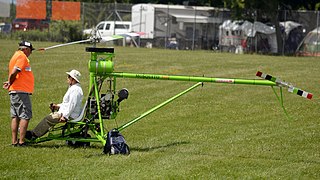Related Research Articles

The Yakovlev Yak-24 is a Soviet twin-engine, tandem rotor, transport helicopter developed by Yakovlev in the 1950s. The Yak-24 saw limited use in the Soviet Air Force, and the exact number produced and duration of service are unknown due to inconsistencies in data.

The Mil Mi-10, given the product number izdeliye 60, is a Soviet military transport helicopter of flying crane configuration, developed from the Mi-6, entering service in 1963. While most versions had been retired by 2009, the short-legged Mi-10K was still in service as of 2014.

The PZL Kania is a follow-up design to the Mil Mi-2 helicopter, developed in Poland by PZL-Świdnik.

The Hughes XH-17 "Flying Crane" was the first helicopter project for the helicopter division of Hughes Aircraft Company. The XH-17, which had a two-bladed main rotor system with a diameter of 134 feet, still holds the world record for flying with the largest rotor system. It was capable of flying at a gross weight of more than 50,000 pounds (23,000 kg), but proved too inefficient and cumbersome to be mass-produced beyond the prototype unit.

The Westland Westminster was a British helicopter of the 1950s from Westland Aircraft. A large cargo design, it was powered by two turboshaft engines driving a single, five-bladed rotor. Initially unclad, the all-metal airframe was later enclosed in a fabric covering. Designed and built as a private venture without government assistance, it was cancelled when Westland took over rival helicopter producers and their more advanced projects.

The McDonnell XV-1 is an experimental Convertiplane developed by McDonnell Aircraft for a joint research program between the United States Air Force and the United States Army to explore technologies to develop an aircraft that could take off and land like a helicopter but fly at faster airspeeds, similar to a conventional airplane. The XV-1 would reach a speed of 200 mph, faster than any previous rotorcraft, but the program was terminated due to the tip-jet noise and complexity of the technology which gave only a modest gain in performance.
The Fiat Model 7002 was a 1960s Italian general-purpose helicopter with a tip jet driven rotor built by Fiat Aviazione. Only one aircraft was built.

The McDonnell XHJH Whirlaway, aka McDonnell Model 37, was a 1940s American experimental transverse-rotor helicopter designed and built by McDonnell Aircraft Corporation for the United States Navy and was the largest helicopter at the time, as well as the first successful twin-engined twin-rotor helicopter in the world.

The SNCASE SE-3101 or Sud-Est SE-3101 was an early, experimental French helicopter with twin tail rotors. Only one was built.

The Airbet Girabet is a family of Spanish autogyros, designed and produced by Airbet of Barcelona. They are all supplied as complete ready-to-fly-aircraft.
The Midwest Zodiac Talon-Turbine is an American helicopter that was designed and produced by Midwest Engineering & Design of Overland Park, Kansas. When it was available the aircraft was supplied in the form of plans for amateur construction, but the plans are no longer advertised for sale.

The Pawnee Warrior was an American helicopter that was designed and produced by Pawnee Aviation of Longmont, Colorado. Now out of production, when it was available the aircraft was supplied as a kit for amateur construction.
The Aero Eli Servizi Yo-Yo 222 is an Italian helicopter designed and produced by Aero Eli Servizi of L'Aquila. The aircraft is supplied complete and ready-to-fly.
The Arrow Coax Livella Uno is a German helicopter under development by Arrow Coax Ultra Light Helicopter of Hornhausen and introduced at the AERO Friedrichshafen airshow in 2015. The aircraft is intended to be supplied as a kit for amateur construction.
The Auroa Helicopters Auroa is a New Zealand helicopter designed and produced by Auroa Helicopters Limited of Manaia, Taranaki, introduced in 2013. The aircraft is supplied complete and ready-to-fly.

The Innovator Mosquito Air is a Canadian helicopter produced by Innovator Technologies of Rockyview, Alberta. The aircraft is supplied as a kit for amateur construction.
The IRI T22B is an Italian helicopter that was designed and produced by Italian Rotors Industries of Aprilia, Lazio. Now out of production, when it was available the aircraft was supplied complete and ready-to-fly.

The Rotorschmiede VA115 is a German helicopter, designed and produced by Rotorschmiede GmbH of Munich, introduced at the AERO Friedrichshafen airshow in 2015. The aircraft is supplied complete and ready-to-fly.
The McDonnell HRH, company designation Model 78, was a 1950s transport helicopter proposal for the United States Marine Corps (USMC) by McDonnell Aircraft, designed to operate from Commencement Bay-class escort carriers.
The McDonnell XHCH was a 1950s aerial crane helicopter proposal for the United States Navy by the McDonnell Corporation.
References
- ↑ "The Evolution of the McDonnell Model 120 Crane Helicopter". ResearchGate. Retrieved 21 November 2020.
- 1 2 3 4 Francillon, René J. (20 September 1990). McDonnell Douglas aircraft since 1920 Vol.2 (2nd ed.). London: Putnam Aeronautical. pp. 172–174. ISBN 978-0851778280.
- ↑ Wilkinson, Paul H. (1966). Aircraft engines of the World 1966/67 (22nd ed.). London: Paul H. Wilkinson. p. 49.